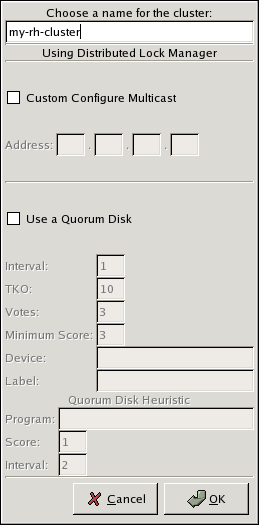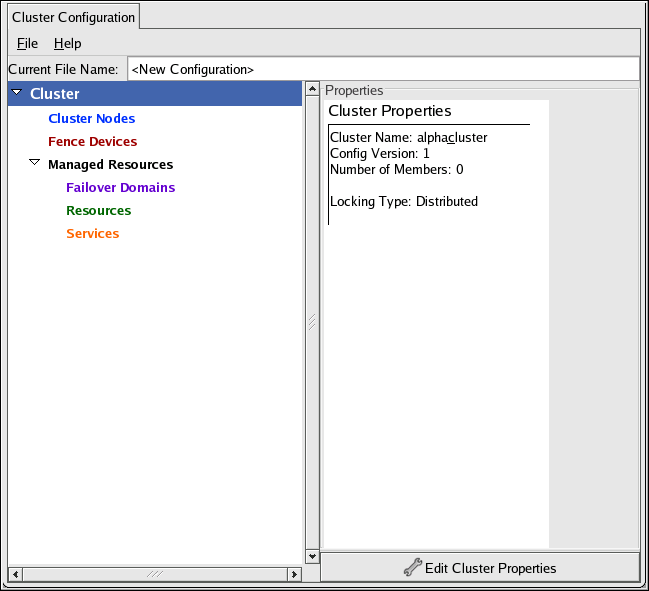Este contenido no está disponible en el idioma seleccionado.
5.2. Starting the Cluster Configuration Tool
You can start the Cluster Configuration Tool by logging in to a cluster node as root with the
ssh -Y command and issuing the system-config-cluster command. For example, to start the Cluster Configuration Tool on cluster node nano-01, do the following:
- Log in to a cluster node and run
system-config-cluster. For example:ssh -Y root@nano-01 . . . system-config-cluster
$ ssh -Y root@nano-01 . . . # system-config-clusterCopy to Clipboard Copied! Toggle word wrap Toggle overflow - If this is the first time you have started the Cluster Configuration Tool, the program prompts you to either open an existing configuration or create a new one. Click to start a new configuration file (refer to Figure 5.1, “Starting a New Configuration File”).
Figure 5.1. Starting a New Configuration File
Note
The tab for the Red Hat Cluster Suite management GUI is available after you save the configuration file with the Cluster Configuration Tool, exit, and restart the Red Hat Cluster Suite management GUI (system-config-cluster). (The tab displays the status of the cluster service manager, cluster nodes, and resources, and shows statistics concerning cluster service operation. To manage the cluster system further, choose the tab.) - Clicking causes the New Configuration dialog box to be displayed (refer to Figure 5.2, “Creating A New Configuration”). The New Configuration dialog box provides a text box for cluster name and the following checkboxes: and . In most circumstances you only need to configure the cluster name.
Note
Choose the cluster name carefully. The only way to change the name of a Red Hat cluster is to create a new cluster configuration with the new name.Custom Configure Multicast
Red Hat Cluster software chooses a multicast address for cluster management communication among cluster nodes. If you need to use a specific multicast address, click the checkbox and enter a multicast address in the text boxes.Note
IPV6 is not supported for Cluster Suite in Red Hat Enterprise Linux 5.If you do not specify a multicast address, the Red Hat Cluster software (specifically,cman, the Cluster Manager) creates one. It forms the upper 16 bits of the multicast address with 239.192 and forms the lower 16 bits based on the cluster ID.Note
The cluster ID is a unique identifier thatcmangenerates for each cluster. To view the cluster ID, run thecman_tool statuscommand on a cluster node.If you do specify a multicast address, you should use the 239.192.x.x series thatcmanuses. Otherwise, using a multicast address outside that range may cause unpredictable results. For example, using 224.0.0.x (which is "All hosts on the network") may not be routed correctly, or even routed at all by some hardware.Note
If you specify a multicast address, make sure that you check the configuration of routers that cluster packets pass through. Some routers may take a long time to learn addresses, seriously impacting cluster performance.Use a Quorum Disk
If you need to use a quorum disk, click the checkbox and enter quorum disk parameters. The following quorum-disk parameters are available in the dialog box if you enable : , , , , , , and . Table 5.1, “Quorum-Disk Parameters” describes the parameters.Important
Quorum-disk parameters and heuristics depend on the site environment and special requirements needed. To understand the use of quorum-disk parameters and heuristics, refer to the qdisk(5) man page. If you require assistance understanding and using quorum disk, contact an authorized Red Hat support representative.Note
It is probable that configuring a quorum disk requires changing quorum-disk parameters after the initial configuration. The Cluster Configuration Tool (system-config-cluster) provides only the display of quorum-disk parameters after initial configuration. If you need to configure quorum disk, consider using Conga instead; Conga allows modification of quorum disk parameters.Overall:Whilesystem-config-clusterprovides several convenient tools for configuring and managing a Red Hat Cluster, the newer, more comprehensive tool, Conga, provides more convenience and flexibility thansystem-config-cluster. You may want to consider using Conga instead (refer to Chapter 3, Configuring Red Hat Cluster With Conga and Chapter 4, Managing Red Hat Cluster With Conga).Figure 5.2. Creating A New Configuration
- When you have completed entering the cluster name and other parameters in the New Configuration dialog box, click . Clicking starts the Cluster Configuration Tool, displaying a graphical representation of the configuration (Figure 5.3, “The Cluster Configuration Tool”).
Figure 5.3. The Cluster Configuration Tool
| Parameter | Description | |||
|---|---|---|---|---|
| Enables quorum disk. Enables quorum-disk parameters in the New Configuration dialog box. | ||||
| The frequency of read/write cycles, in seconds. | ||||
| The number of cycles a node must miss in order to be declared dead. | ||||
| The number of votes the quorum daemon advertises to CMAN when it has a high enough score. | ||||
The minimum score for a node to be considered "alive". If omitted or set to 0, the default function, floor((n+1)/2), is used, where n is the sum of the heuristics scores. The value must never exceed the sum of the heuristic scores; otherwise, the quorum disk cannot be available. | ||||
| The storage device the quorum daemon uses. The device must be the same on all nodes. | ||||
Specifies the quorum disk label created by the mkqdisk utility. If this field contains an entry, the label overrides the field. If this field is used, the quorum daemon reads /proc/partitions and checks for qdisk signatures on every block device found, comparing the label against the specified label. This is useful in configurations where the quorum device name differs among nodes. | ||||
|


